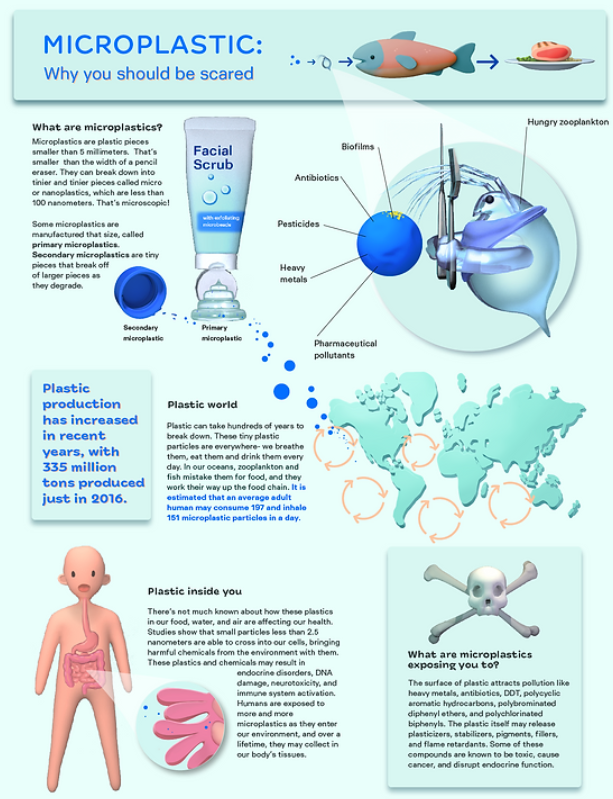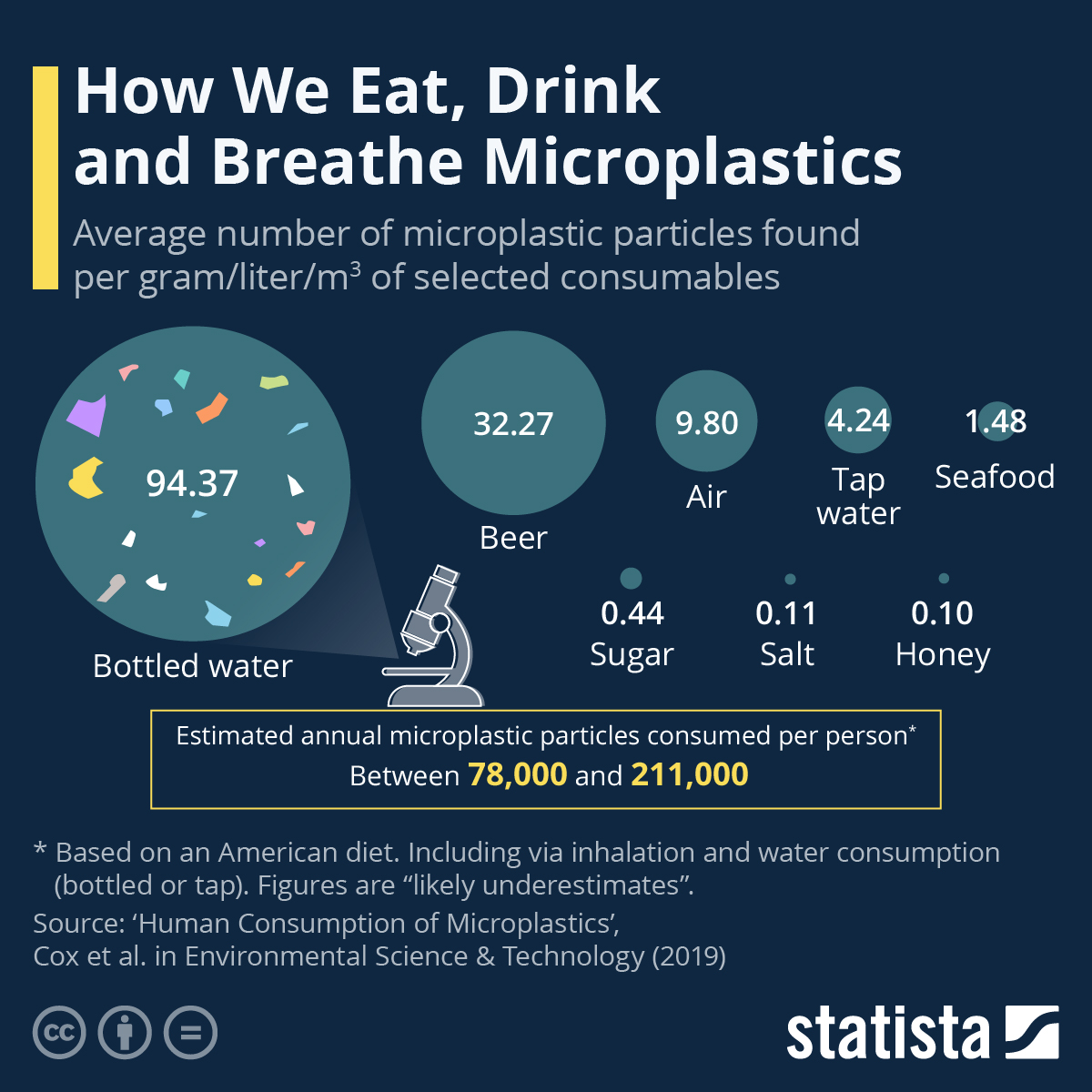Microplastics are small pieces of plastic, specifically less than five millimeters or 0.2 inches in diameter.
These tiny yet destructive forces are formed either as primary commercial products for use in cosmetics, fishing nets etc. or as remnants of larger plastics post any wear & tear exerted by various environmental factors such as wind, water, heat etc.
These microplastics can particularly be harmful to our planet waters, especially its aquatic life. Plastic goes unnoticed and untroubled because of its extensive use in the human world yet is continuously proving detrimental to even human health.
Microplastics are even bigger troublemakers because of their small size and excellent penetration almost anywhere. No doubt, they can be found from the deepest point of the earth’s surface called the Mariana trench existing at 10,927 mtrs in the Pacific to the highest altitudes of mount Everest at 8,440 mtrs above sea level.
Production of plastics across the globe has increased from 2 million tons per annum in 1950, to more than 450 million tons in the current times.
If we believe a widely available calculation, around 9 billion tons of plastic has already been produced, half of which has reached the landfills. This will amount to more than 11 billion tons of plastic sustaining in the environment till 2025.
Here is a look at top 5 weirdest of places for the planet’s microplastics to have existed and found recently. But thanks to us humans, they do!
1. In Human Placentas
Human placenta is a supplementary organ in females that performs the function of providing oxygen and nutrients from the mother’s body to its growing foetus. In one of its kind of a study, microplastics have been traced in the placenta of Hawaiian mothers.
This scenario can inhibit brain growth of the baby, cause sight and neuro related problems. However, the study could not ascertain if these microplastics can travel through the umbilical cord to the baby.
This highlights the vulnerable condition of Pacific Island communities and their sensitive nature to plastic pollution caused by better privileged nations.
A participant of the study explains: “We believe that the plastics may be floating around in food or being inhaled. It’s coming through our digestive fluids or lungs, and the particles are getting absorbed through the gut and traveling through the bloodstream, and then somehow collecting in the placenta during pregnancy.”
With relentless consumption and production of plastic, this seems possible.
And it is not just placenta that hosts this deadly material, humans’ lungs take in plastic equivalent to a debit card every week and some pieces do get stuck there.
Similar fragments have also been found in drinking water and consequently even in mother’s breastmilk or faeces of newly born humans. Name a possible place and microplastics will rule it.
2. Inside Clouds
Microplastics have also made its way to the top quite literally i.e., it has now registered its presence inside the clouds, provoking rains and altering climatic phenomena across the globe.
A study collected water samples from mists surrounding the peaks of Mount Fuji and Mount Oyama in Japan only to find nine different kinds of polymers and a type of rubber indicating their vicious presence inside the clouds that bear them. This concluded the airborne microplastics (AMPs) to be abundant enough in playing a key role in cloud formation, precipitation and overall climate.
With such an elaborate usage of plastics in every human life, the inventors of plastic would have been proudest in their legacies. They must have envisaged a complete transformation of society and the ease of living but they must have been oblivious and would have detested the idea of existence of their race seeding from plastics.
Because of the proportion of plastics to the total aerosol components is tiny, the overall impact on the planet’s climate is not significant yet the microplastics might aid in reflecting or absorbing sunlight described as “radiative forcing.
“We are still learning what the impacts are for humans, ecosystems, and climate. But certainly, from what we know so far, it doesn’t look good”, explains a researcher.
3. In Bee Hives
Another study based in Denmark observed the bees from 19 hives in and around their capital city. Under microscopes, they could find the traces of microplastics on bees collected from the city and the countryside. Microplastic pieces were significantly found on worker bees.
The process or reasoning behind the microplastic collection by these bees remain unknown whether they carried it when flying in the air or from the pollens they transported.
4. Interiors of Marine Animals
The University of Exeter and Plymouth Marine Laboratory recently filed research papers claiming that they end up finding specks of microplastics in almost every mammal they studied.
Microplastics have invaded the food chains.
This happens as microplastics absorb toxins like copper and heavy metals like lead, or mercury. When the small fishes ingest these microplastics, these toxic metals if present end up accumulating in the higher levels of food chain.
As humans consume the sea food, these heavy metals find their way in.
Similarly, microplastics in marine animals especially fishes, restrict their fertility and reproduction. With this continuous infiltration happening, complete wipe out of any species of fish will not be difficult.
5. Foods and Beverages
A 2020 study on the similar lines looked for microplastics in food and beverages stored in glass containers. Beer, honey, and milk, all had microplastics and other contaminants.
It is humanly possible that drinking water composed of microplastics or eating fish, honey, milk loaded with plastics, heavy metals or other toxins can impact our digestive tract.
Whatever we consume comes out as human excreta. It travels from our poor & insufficient disposal arrangements and find a way back to the drinking water treatment plants, maybe mixing with rivers or oceans.
The problem can be summarized in these words of a researcher: “These plastics are incredibly long lived. They’re breaking down, and they’re going to be forming new microplastics for centuries. We just don’t know how big the problem is that we’ve committed ourselves to.”
Indeed, the recycled world will be a better world.



